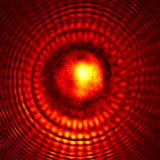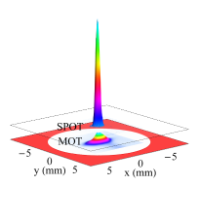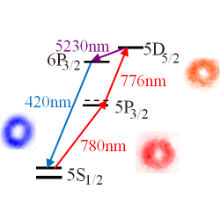Structures in cold atoms
Spatially dependent transparency
 Atoms cast a shadow in a light beam - a technique that is commonly used to infer the density and shape of a cloud of cold atoms. Under certain conditions, atoms can however become transparent to a passing light beam, an effect known as electromagnetically induced transparency (EIT). We are using the polarisation profile across our probe light beam to control the opacity of the atoms, generating alternating areas of transparency and opacity.
Atoms cast a shadow in a light beam - a technique that is commonly used to infer the density and shape of a cloud of cold atoms. Under certain conditions, atoms can however become transparent to a passing light beam, an effect known as electromagnetically induced transparency (EIT). We are using the polarisation profile across our probe light beam to control the opacity of the atoms, generating alternating areas of transparency and opacity.
Read more in Phys. Rev. Lett 114, 123603 (2015)
High density atom trap, based on holographically shaped repump lasers
 We have recently developed a trap design which allows us to increase the atomic density by 2 orders of magnitude, obtaining atom densities of over 1012/cm3.
We have recently developed a trap design which allows us to increase the atomic density by 2 orders of magnitude, obtaining atom densities of over 1012/cm3.
Holographic control of the light beams and dynamic switching from a standard magneto-optical trap (MOT) to a dark SPOT configuration allows us to optimize the trapping geometry.
Read more in Phys. Rev. A 88, 043409 (2013)
We are currently investigating the interaction of atoms confined in our high density with shaped light beams.
Orbital angular momentum transfer from IR to blue light via four-wave mixing
 Atomic vapours at moderate temperatures allow the observation of non-linear effects if driven by light at low intensities. We have showed the highly efficient generation of blue light by pumping a rubidium vapour with two infrared lasers via a four-wave mixing process.
Atomic vapours at moderate temperatures allow the observation of non-linear effects if driven by light at low intensities. We have showed the highly efficient generation of blue light by pumping a rubidium vapour with two infrared lasers via a four-wave mixing process.
Read more in Optics Express, Vol. 18, 17020 (2010).
Pumping the atoms with light beams that carry orbital angular momentum, we find that the total orbital angular momentum of the pump light is transferred to the generated blue light. Pumping with more complicated light profiles results in blue light modes that are determined by phase-matching within the atoms.
Read more in Phys.Rev.Lett. 108, 243601 (2012).

